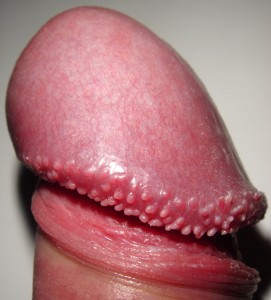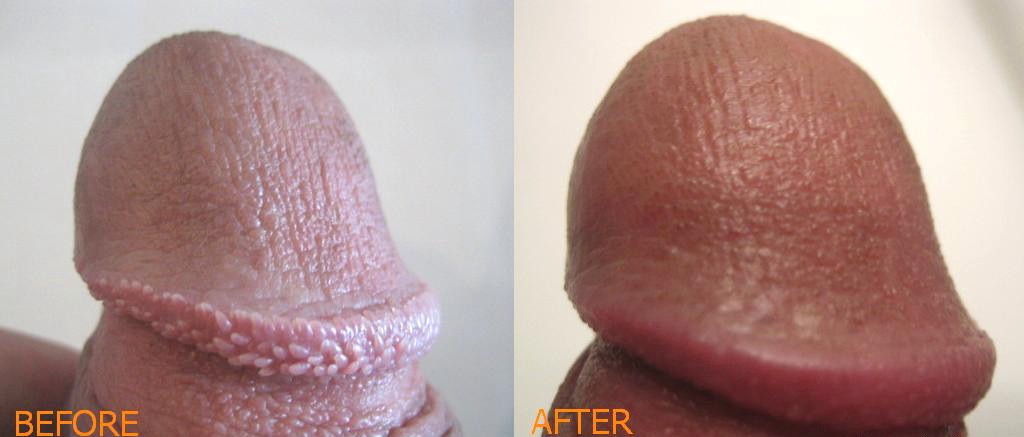Pearly Penile Papules | PPP
Pearly penile papules (PPP) are small tentacles found on the rim of the glans head of the penis seen in some men. They are a genetic variant. Although harmless, they are considered unsightly anatomical variation. Sometimes they are confused with genital warts. Genital warts which look somewhat similar are a completely different condition caused by HPV infection which is a sexually transmitted disease. However, pearly penile papules are not a sexually transmitted disease. They are not an infection and are not contagious.

Appearance
The pearly penile papules, PPP appear as one or several rows of small, pearly or flesh-coloured, smooth, dome-topped bumps situated around the rim surrounding the head of the penis, circumferential or just at the region of the sulcus of the glans penis. They may range in size from less than 1 mm to 3 mm. The condition is common and estimated to be present in a 10-15% of adult men. Studies suggest that it occurs more often on younger men and those who have not been circumcised.
Pearly penile papules, PPP can appear in one or several rows of small. They vary in size from just a tiny notch t a couple of millimetres long. Sometimes there are a handful of them while other times they’re densely packed. They are flesh-coloured, smooth, dome-topped bumps.
Common Condition
The condition is estimated to affect 16% of men. The more erect the penis is, the more prominent the papules become. People affected by the condition are usually apprehensive about being intimate with others and experience sexual anxiety. Many PPP sufferers are self-conscious of their condition and feel embarrassed to discuss it with others. We have encountered men who chose to celibacy because of it.
Develop Puberty
They usually develop at the time of sexual maturity. PPP are usually situated around the rim surrounding the head of the penis, circumferential or just at the region of the sulcus of the glans penis. They may range in size from less than 1 mm to 3 mm. At puberty, affected boys don’t know who to turn to. Sensitive about the condition they turn to online search. Eventually they learn about about the condition and seek help.
Shared Mammals
Pearly penile papules are also known as just PPP are sometimes described as redundant remnants of penile spines, sensitive features found in the same location in other primates. In species which retain the full expression of penile spines, the spines contribute to sexual pleasure and quicker orgasms of both the male and the female.
Related Blogs:
Dr Kahlout has been treating PPP since the mid 90’s. So much has changed since then. He’s seen technology evolving to modern safe effective treatments with lasers and plasma as well as SWD. He shares his personal views and medical experience about Pearly Penile Papules (PPP) treatment in a series of clinic blogs. To find out more please click one of the links below:
A similar expression, vestibular papillomatosis of the vulva or hirsuties papillaris vulvae, occurs in females and similarly can be misinterpreted as an outbreak of the HPV infection. Like hirsuties papillaris genitalis, it is a normal variation on human anatomy.
Treatment
While PPP pose no risk to a male’s physical health or sexual reproductive life, some men or their sexual partners may consider them aesthetically displeasing. They are found to be distressing psychologically. Having pearly penile papules does contribute to poor self-esteem. We see many men suffering from PPP deliberately choosing not to have an intimate partner due to those unsightly pearly penile papules.
There are several medical ways to remove them. Like any elective medical procedure, there is always some risk of unexpected consequences, so only doctors with sexual medicine and surgical experience are advised to remove them. Pearly Penile Papule treatments are performed at Castleknock Cosmetic Clinic, Dublin. Dr Kahlout has considerable experience in sexual medicine.
Plasma Skin Beam
Plasma skin beam, is a new non-laser technology that uses plasma, which is a burst of energy using advanced algorithm radiofrequency (RF) to provide a thermal burst of energy into the Pearly Penile Papules PPP just below the skin surface. Unlike lasers which use light energy to target a specific component of the papules, this device uses pulses of ionised inert nitrogen gas to alter structures below the surface of the skin. The skin above it is not removed until the next day when the treated and damaged pearly penile papules sloughs off and separate from the overlying skin leaving evenly contoured skin behind. The peeling continues for about 7 to 10 days.

Fractional CO2
The most popular treatment is using a Fractionated CO2 laser to treat the pearly penile papules, PPP. Fractional CO2 laser procedure is popular skin resurfacing procedure. The same laser technology but with different parameters is painlessly utilised to treat those unwanted pearly penile papule spines. The procedure is performed under local anaesthesia. The procedure normally takes 30 minutes to perform and does not require in-hospital stay. Discomfort should be minimal with the use of long lasting local anaesthesia block. The expected recovery time is limited to a few days, and return to normal activities in a couple of weeks.
Hyfrecation Surgery
Another alternative procedure to treating pearly penile papules is a procedure that involves short wave diathermy (SWD) hyfrecation. The SWD procedure is performed with a high precision hyfrecator and should take less than an hour to perform. The SWD uses electromagnetism to deposit measured amounts of energy into the undesired PPP.
All these procedures are good in clearing the patient from the unsightly PPP, however the Plasma and CO2 laser do have the more favourable success and a better aesthetic outcome than SWD.




